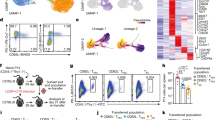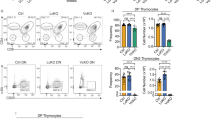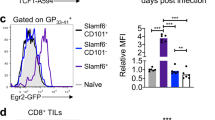Abstract
T lymphocytes circulate in a quiescent state until they encounter cognate antigen bound to the surface of an antigen-presenting cell. The molecular pathways that regulate T cell quiescence remain largely unknown. Here we show that forced expression of the lung Krüppel-like transcription factor (LKLF) in Jurkat T cells is sufficient to program a quiescent phenotype characterized by decreased proliferation, reduced cell size and protein synthesis and decreased surface expression of activation markers. Conversely, LKLF-deficient peripheral T cells produced by gene targeting showed increased proliferation, increased cell size and enhanced expression of surface activation markers in vivo. LKLF appeared to function, at least in part, by decreasing expression of the proto-oncogene encoding c-Myc. Forced expression of LKLF was associated with markedly decreased c-Myc expression. In addition, many effects of LKLF expression were mimicked by expression of the dominant-negative MadMyc protein and rescued by overexpression of c-Myc. Thus, LKLF is both necessary and sufficient to program quiescence in T cells and functions, in part, by negatively regulating a c-Myc–dependent pathway.
This is a preview of subscription content, access via your institution
Access options
Subscribe to this journal
Receive 12 print issues and online access
$209.00 per year
only $17.42 per issue
Buy this article
- Purchase on Springer Link
- Instant access to full article PDF
Prices may be subject to local taxes which are calculated during checkout








Similar content being viewed by others
References
Abbas, A. K., Lichtman, A. H. & Pober, J. S. Cellular and Molecular Immunology, 2nd edn (W.B. Saunders, London, 1994).
Freitas, A. A. & Rocha, B. Population biology of lymphocytes: the flight for survival. Annu. Rev. Immunol . 18, 83–111 (2000).
Perkins, A. Erythroid Krüppel-like factor: from fishing expedition to gourmet meal. Int. J. Biochem. Cell Biol. 31, 1175–1192 (1999).
Segre, J., Bauer C. & Fuchs, E. Klf4 is a transcription factor required for establishing the barrier function of skin. Nature Genet. 22, 356–360 (1999).
Kuo, C. T. et al. The LKLF transcription factor is required for normal tunica media formation and blood vessel stabilization during murine embryogenesis. Genes Dev. 11, 2996–3006 (1997).
Coghill, E. et al. Erythroid Krüppel-like factor (EKLF) coordinates erythroid cell proliferation and hemoglobinization in cell lines derived from EKLF null mice. Blood 97, 1861–1868 (2001).
Shields, J. M., Christy, R. J. & Yang, V. W. Identification and characterization of a gene encoding a gut-enriched Krüppel-like factor expressed during growth arrest. J. Biol. Chem. 271, 20009–20017 (1996).
Kuo, C. T., Veselits, M. L. & Leiden J. M. LKLF: A transcriptional regulator of single-positive T cell quiescence and survival. Science 277, 1986–1990 (1997).
Schober, S. L. et al. Expression of the transcription factor Lung Krüppel-Like Factor is regulated by cytokines and correlates with survival of memory T cells in vitro and in vivo. J. Immunol. 163, 3662–3667 (1999).
Sprent, J. & Surh, C. D. Generation and maintenance of memory T cells. Curr. Opin. Immunol. 13, 248–254 (2001).
Gossen, M. et al. Transcriptional activation by tetracyclines in mammalian cells. Science 268, 1766–1769 (1995).
Berns, K., Hijmans, E. M. & Bernards, R. Repression of c-Myc responsive genes in cycling cells causes G1 arrest through reduction of cyclinE/CDK2 kinase activity. Oncogene 15, 1347–1356 (1997).
Cazzola, M., Bergamaschi, G., Dezza, L. & Arosio, P. Manipulations of cellular iron metabolism for modulating normal and malignant cell proliferation: Achievements and prospects. Blood 75, 1903–1908 (1990).
Ellis, T. M., Simms, P. E., Slivnick, D. J., Jäck, H.-M. & Fisher, R. I. CD30 is a signal-transducing molecule that defines a subset of human activated CD45RO T cells. J. Immunol . 151, 2380–2389 (1993).
Aizawa, S. et al. Tumor necrosis factor receptor-associated factor (TRAF) 5 and TRAF 2 are involved in CD30-mediated NFκB activation. J. Biol. Chem. 272, 2042–2045 (1997).
Gilfillan, M. C., Noel, P. J., Podack, E. R., Reiner, S. L. & Thompson, C. B. Expression of the costimulatory receptor CD30 is regulated by both CD28 and cytokines. J. Immunol. 160, 2180–2187 (1998).
Gregory, S. et al. Role of the CD1a molecule in the superantigen-induced activation of MHC class II negative human thymocytes. Hum. Immunol. 61, 427–437 (2000).
Mateyak, M. K., Obaya, A. J. & Sedivy, J. M. c-Myc regulates cyclin D-CDK4 and -CDK6 activity but affects cell cycle progression at multiple independent points. Mol. Cell. Biol. 19, 4672–4683 (1999).
Iritani, B. M. & Eisenman, R. N. c-Myc enhances protein synthesis and cell size during B lymphocyte development. Proc. Natl Acad. Sci. USA 96, 13180–13185 (1999).
Johnston, L. A., Prober, D. A., Edgar, B. A., Eisenman, R. N. & Gallant, P. Drosophila myc regulates cellular growth during development. Cell 98, 779–790 (1999).
Mateyak, M. K., Obaya, A. J., Adachi, S. & Sedivy, J. M. Phenotypes of c-Myc-deficient rat fibroblasts isolated by targeted homologous recombination. Cell Growth Differ . 8, 1039–1048 (1997).
Wu, K.-J., Polack, A. & Dalla-Favera, R. Coordinated regulation of iron-controlling genes, H-ferritin and IRP2, by c-Myc. Science 283, 676–679 (1999).
Brunner, T. et al. Expression of Fas ligand in activated T cells is regulated by c-Myc. J. Biol. Chem. 275, 9767–9772 (2000).
Spencer, C. A., LeStrange, R. C., Novak, U., Hayward, W. S. & Groudine, M. The block to transcriptional elongation is promoter dependent in normal and Burkitt's lymphoma c-myc alleles. Genes Dev. 4, 75–88 (1990).
Sussman, D. J., Chung, J. & Leder, P. In vitro and in vivo analysis of the c-myc RNA polymerase III promoter. Nucleic Acids Res. 19, 5045–5052 (1991).
Krumm, A., Meulia, T., Brunvand, M. & Groudine, M. The block to transcriptional elongation within the human c-myc gene is determined in the promoter-proximal region. Genes Dev. 6, 2201–2213 (1992).
Ryan, K. M. & Birnie, G. D. Myc oncogenes: the enigmatic family. Biochem. J. 314, 713–721 (1996).
Tripathy, S. K., Goldwasser, E., Lu, M., Barr, E. & Leiden, J. M. Stable delivery of physiologic levels of recombinant erythropoietin to the systemic circulation by intramuscular injection of replication-defective adenovirus. Proc. Natl Acad. Sci. USA 91, 11557–11561 (1994).
Carayon, P. & Bord, A. Identification of DNA-replicating lymphocyte subsets using a new method to label the bromo-deoxyuridine incorporated into the DNA. J. Immunol Meth. 147, 225–230 (1992).
Acknowledgements
We thank M. Vander Heiden and C. Thompson for ATP measurements and helpful discussions; K. Sigrist, R. Wei, Y. Lin for technical assistance; J. Auger, A. Lin, I. Ho for technical advice; R. Bernards for pCMVMadMyc; R. Eisenman for pSP271myc; H. Bujard for Tet-inducible plasmids; G. Nolan for pRVNL3; A. Krumm for ΔP1CAT; D. Marshall for pGEMAdEF1; C. Ting for the use of data before publication; J. Bluestone, A. Ma, M. Peter, D. Strauss and J. Quintans for helpful discussions; E. Kaji, J. Lepore, G. Huggins and G. Reed for critical reading of the manuscript. Supported by a grant from N.I.H. (to J. M. L.) and by NIGMS (A. F. B.).
Author information
Authors and Affiliations
Corresponding author
Rights and permissions
About this article
Cite this article
Buckley, A., Kuo, C. & Leiden, J. Transcription factor LKLF is sufficient to program T cell quiescence via a c-Myc–dependent pathway. Nat Immunol 2, 698–704 (2001). https://doi.org/10.1038/90633
Received:
Accepted:
Issue Date:
DOI: https://doi.org/10.1038/90633
This article is cited by
-
Acute type adult T-cell leukemia cells proliferate in the lymph nodes rather than in peripheral blood
Cancer Gene Therapy (2022)
-
Rethinking peripheral T cell tolerance: checkpoints across a T cell’s journey
Nature Reviews Immunology (2021)
-
The mediator subunit Med23 contributes to controlling T-cell activation and prevents autoimmunity
Nature Communications (2014)
-
HIV restriction in quiescent CD4+T cells
Retrovirology (2013)
-
GATA-3 controls the maintenance and proliferation of T cells downstream of TCR and cytokine signaling
Nature Immunology (2013)



